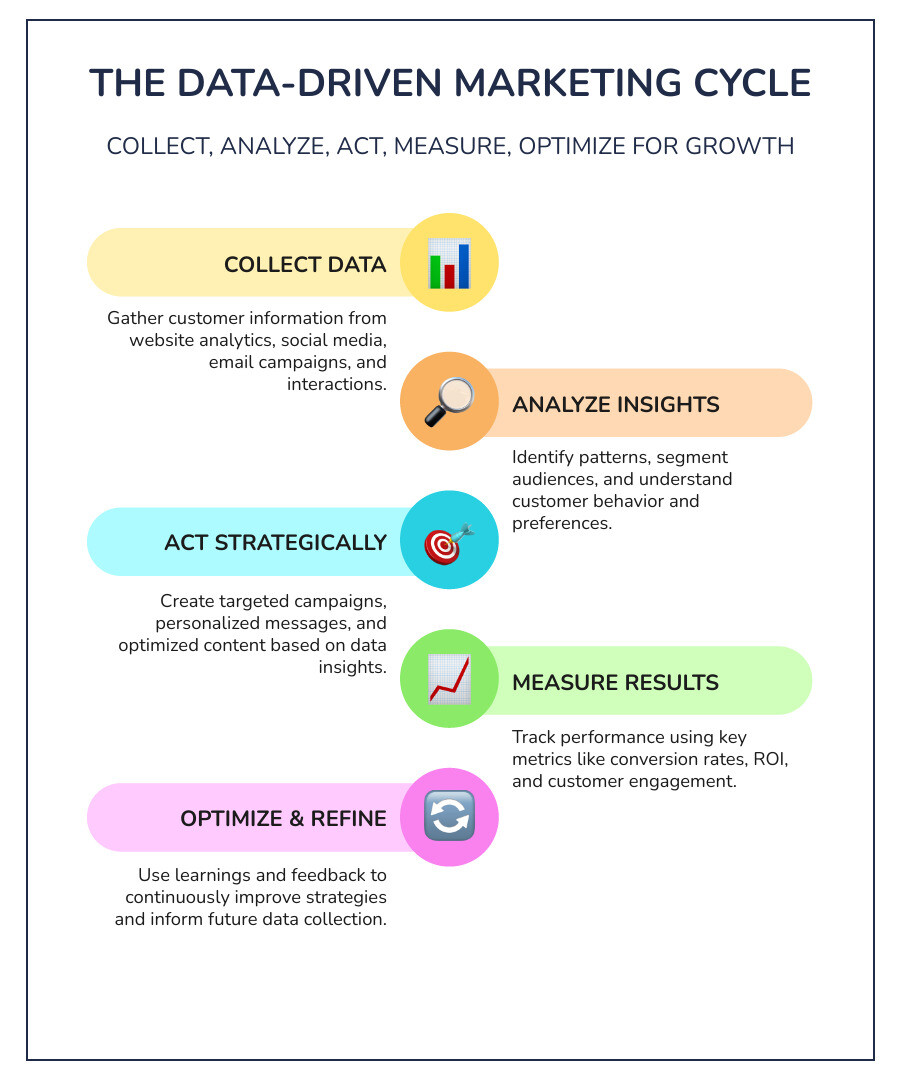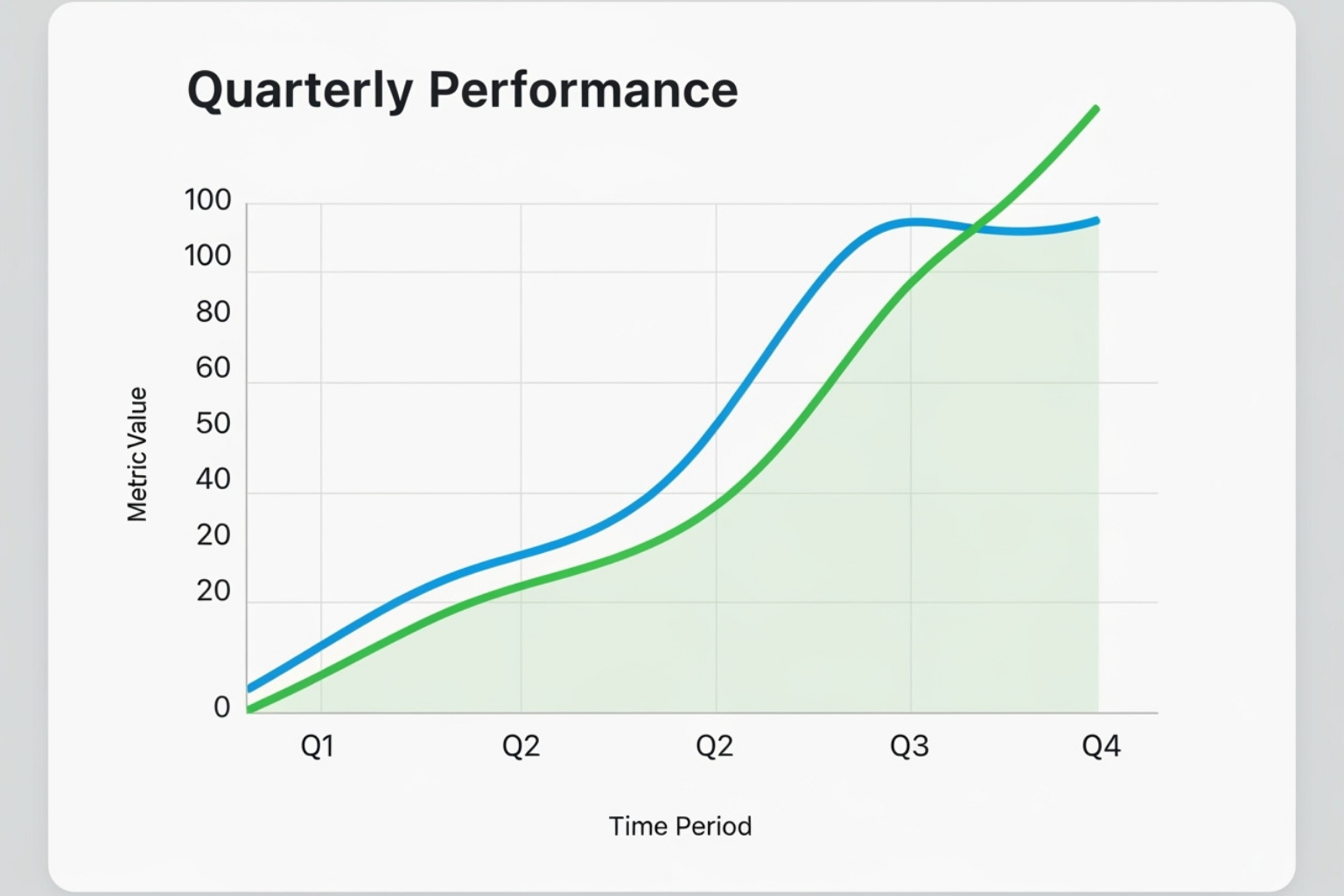Data-driven marketing: Unstoppable 2025 Growth
Why Data-Driven Marketing is the Key to Unstoppable Growth
Data-driven marketing is an approach that uses customer data to guide marketing decisions, create targeted campaigns, and personalize customer experiences—replacing guesswork with certainty.
Instead of relying on gut instinct, you use concrete data to understand what works, leading to higher ROI and measurable results. In fact, studies show that 2 out of 3 leading marketers agree that data-based decisions beat gut instinct.
If you’re struggling with low online visibility, you might be creating content without knowing what your audience wants or spending money on campaigns without proof they’re working. The truth is simple: guessing doesn’t scale. Certainty does.
Successful businesses use customer data to understand exactly what their audience needs. This shift from intuition to insight is what separates predictable growth from stagnation. The good news is you don’t need a massive budget to start—just a commitment to making informed decisions.
This guide will show you how to build and execute a data-driven marketing strategy for sustainable online growth.

What is Data-Driven Marketing and Why Does it Matter?
Data-driven marketing replaces guesswork with real customer information. Instead of blasting a generic message and hoping it works, you analyze customer data to create targeted campaigns that you know will resonate.
The difference is stark:
| Feature | Traditional Marketing | Data-Driven Marketing |
|---|---|---|
| Audience Approach | Broad, generic messages | Targeted segments, personalized communications |
| Decision Making | Intuition, gut feeling, past habits | Data-backed insights, analytical reasoning |
| Measurement | Difficult, often anecdotal | Clear ROI tracking, measurable campaign performance |
| Customer View | General demographics | Detailed profiles, behavioral patterns |
| Adaptability | Slow, reactive | Real-time adjustments, proactive optimization |
Customers now demand personalization. 71% of consumers expect companies to deliver personalized interactions, and 76% get frustrated when they don’t. For businesses serious about growth, data-driven marketing is essential for competing effectively and is fundamental to mastering effective web marketing strategies for modern needs.
The Core Benefits for Your Business
Data-driven marketing delivers measurable improvements to your bottom line.

- Higher ROI: Stop wasting money on audiences who won’t convert. Businesses using personalization see 5x–8x higher ROI.
- Improved Customer Experience: Anticipate customer needs and provide solutions, building trust at every step.
- Better Decision-Making: Use clear data to see what’s working, adapt quickly, and make choices with confidence.
- Increased Lead Conversion: Reach the right people at the right time. 78% of organizations report that data-driven marketing increases lead conversion.
- Improved Customer Loyalty: When customers feel understood, they stick around, increasing their lifetime value.
Key Types of Data Analytics
Three types of analytics power your strategy:
- Descriptive Analytics: Answers What happened? It shows past performance, like website visits or open rates.
- Predictive Analytics: Asks What could happen next? It forecasts future trends, like which customers are likely to buy.
- Prescriptive Analytics: Answers What should we do about it? It recommends specific actions to achieve a desired outcome.

These work in a continuous cycle: use descriptive analytics to understand the past, predictive to anticipate the future, and prescriptive to determine your next move. This transforms data from a buzzword into a competitive advantage.
How to Build a Winning Data-Driven Strategy
Building a successful data-driven marketing strategy requires a methodical approach where numbers—not your gut—guide your decisions.
Step 1: Define Goals and Collect Quality Data
Start with crystal-clear, measurable goals. Whether it’s increasing traffic by 30% or generating 50 more leads per month, tie your goals to specific Key Performance Indicators (KPIs) to track progress.
Next, collect the right data. First-party data (from your website, CRM, etc.) is your most valuable asset. You can supplement it with second-party data (from partners) and third-party data (from aggregators).
Data quality is critical. With only 3% of companies’ data meeting basic quality standards, flawed data leads to flawed insights. Data hygiene—regular cleaning and validation—is essential. For local businesses, this starts with accurate online listings, which GMB Optimization Services can help ensure.
Step 2: Analyze Data for Segmentation and Personalization
Turn raw numbers into actionable insights through customer segmentation. Divide your audience into smaller groups based on:
- Demographics (age, location)
- Behaviors (purchase history, browsing)
- Psychographics (interests, values)
Segmentation enables personalization tactics that go beyond a first name in an email. Show product recommendations based on browsing history, customize website content, or send targeted offers for abandoned carts. 71% of consumers expect personalized interactions.
Use customer journey mapping to visualize the path from awareness to purchase. Analyzing data at each stage helps you optimize touchpoints, a key part of Strategic Marketing Services for Visibility.
Step 3: Implementing and Measuring Your Data-Driven Marketing Campaigns
Turn insights into action and measure everything.
-
A/B testing lets you scientifically test variations of an email, landing page, or ad to see which performs better. This replaces opinions with facts.
-
Attribution models help you understand which marketing touchpoints led to a conversion. Choosing the right model (e.g., first-touch, last-touch, linear) helps you accurately assess ROI.
-
ROI optimization is the ultimate goal. Continuously measure performance, adjust strategies based on data, and refine your approach by scaling what works.
Use a marketing dashboard to manage this process.

A good dashboard consolidates key metrics like click-through rates (CTR), conversion rates (CVR), and return on ad spend (ROAS) into one view for quick assessment and rapid decision-making. Foster a culture of continuous learning and iteration.
Essential Tools for Your Data-Driven Marketing Stack
Executing a data-driven marketing strategy requires the right toolkit. Your marketing stack transforms raw data into action. The key is choosing tools that integrate seamlessly for a unified customer view.

Analytics and Visualization
-
Web Analytics: Google Analytics is the standard for tracking traffic, user behavior, and conversions.
-
Heatmaps & Session Replays: Free tools like Microsoft Clarity show where users click and scroll and let you watch session recordings to find friction points.
-
Data Visualization: Data visualization platforms turn complex data into easy-to-understand dashboards for monitoring KPIs.
Automation and Customer Management
-
CRM (Customer Relationship Management): A CRM is your central hub for all customer data, creating a 360-degree view of every interaction.
-
Marketing Automation: Marketing automation platforms let you build automated workflows, such as welcome emails or abandoned cart reminders.
-
Email Marketing: Dedicated email marketing tools offer advanced segmentation and personalization to maximize email ROI.
Many of these platforms also include customer journey mapping features to help you optimize the customer path. Start with the essentials and expand as you grow.
Overcoming Common Challenges in Data-Driven Marketing
Putting data-driven marketing into practice can be complex, with research showing that 81% of marketers find it challenging. Understanding these common roadblocks is the first step to overcoming them.
-
Data Silos: Data is often isolated in different systems (CRM, analytics), preventing a unified customer view. The solution is to integrate systems and foster inter-departmental collaboration.
-
Poor Data Quality: Bad data leads to bad decisions. With only 3% of companies’ data meeting basic quality standards, regular data cleaning and validation are non-negotiable.
-
The Skills Gap: Many teams lack the expertise to analyze complex data. You can train your team, hire specialists, or partner with experts. Streamlining your SEO efforts using outsourced services can provide the needed expertise without the overhead.
-
Data Privacy and Compliance: Beyond regulations like GDPR, trust is paramount. 79% of consumers will leave a company that uses their data without their knowledge. Be transparent, make opt-outs easy, and prioritize security.
-
Translating Data into Action: It’s easy to get stuck in “analysis paralysis.” To avoid this, assign ownership to insights, set deadlines, and create a feedback loop of testing, measuring, and iterating.
The Future of Marketing is Data-Driven
The shift toward data-driven marketing is accelerating. Businesses that thrive will be those that use data to truly understand their audiences.
Real-World Examples of Success
-
GreenPal used census data to find price-sensitive zip codes. A hyper-targeted ad for this segment resulted in a 200% lift in CTR and a 30% increase in conversions.
-
Vodafone Italy integrated its scattered customer data into one platform, allowing them to identify upsell opportunities and proactively reduce churn.
-
Netflix uses viewing data to power its recommendation engine and content strategy, producing shows they know audiences want to see.
The Future of Data-Driven Marketing
Several powerful trends are reshaping the landscape:
-
AI and Machine Learning: These are becoming essential for processing massive datasets, identifying patterns, and automating optimization.
-
Hyper-personalization: The future is about delivering unique, real-time experiences to individuals across all touchpoints.
-
Predictive and Prescriptive Analytics: AI will not only forecast behavior but also recommend the specific actions you should take.
-
The Cookieless Future: The phase-out of third-party cookies makes first-party data, collected with consent, more valuable than ever.
-
Data Privacy and Ethics: Transparency and trust will become core brand values, not just compliance checkboxes.
The world is expected to produce 181 zettabytes of data by 2025. Navigating this requires continuous adaptation and innovative strategies, like those in Link Building 2025. Success will belong to those who turn data into action.
Frequently Asked Questions about Data-Driven Marketing
Here are answers to common questions about data-driven marketing.
What is the first step in creating a data-driven marketing strategy?
The first step is defining clear, measurable goals. A specific target—like increasing leads by 20%—determines which data to collect, which metrics to track, and how to measure success.
Can small businesses benefit from data-driven marketing?
Absolutely. Small businesses can start with free tools like Google Analytics and the analytics on social media and email platforms. This first-party data is incredibly valuable. Focus on the basics: who visits your site, what they look at, and what converts them. If you need help, companies like MDM Marketing make data-driven marketing accessible for all businesses.
How does data-driven marketing improve ROI?
It improves ROI through precision, personalization, and clear attribution.
- Precision reduces wasted ad spend by targeting the right people.
- Personalization drives higher conversion rates with relevant messages. Businesses using it see 5x to 8x higher ROI.
- Attribution shows which channels work, so you can invest wisely.
This approach turns your marketing budget from a gamble into a predictable investment.
Conclusion
The era of marketing by gut feeling is over. Data-driven marketing is the foundation for sustainable growth in today’s digital landscape.
You now understand how to shift from guessing to knowing by collecting quality data, segmenting your audience, and personalizing experiences. But understanding is only the beginning—real change happens when you take action.
Start small. Pick one goal, collect the data, analyze it, test a hypothesis, and measure the results. This iterative process of making small, informed decisions is how sustainable growth happens. Each insight builds on the last, improving your ROI and strengthening customer loyalty.
The businesses winning today aren’t the ones with the biggest budgets; they’re the ones making the smartest decisions based on real customer data.
If you’re ready to stop guessing and start investing in strategies backed by evidence, you don’t have to do it alone. MDM Marketing, based in North Canton, OH, specializes in turning complex data into clear action plans that drive measurable results.
Your customers are telling you what they want. The question is: are you listening?
About The SEO Experts at MDM Marketing
This author hasn't written a bio yet.
